Cryptocurrency, often known as digital currency, is a significant shift in how we think about and handle money. Being familiar with different forms of payment is essential because the world is becoming more and more digital every day.
What is digital currency?
Electronic currency or digital money is represented as an alternative to performing in electronic form (not physical, no coin and paper money).
They are the virtual currencies used in transactions on a digital platform on the internet or a defined digital system and are normally decentralized using blockchain technology (though they can be centralized currencies). Well-known examples of these are cryptocurrencies (Bitcoin & Ethereum), as well as some of the many central bank digital currencies (CBDC). A digital currency transaction is faster and less risky than one using conventional payment methods, albeit borderless.

What is digital currency?
Electronic currency or digital money is represented as an alternative to performing in electronic form (not physical, no coin and paper money).
They are the virtual currencies used in transactions on a digital platform on the internet or a defined digital system and are normally decentralized using blockchain technology (though they can be centralized currencies). Well-known examples of these are cryptocurrencies (Bitcoin & Ethereum), as well as some of the many central bank digital currencies (CBDC). A digital currency transaction is faster and less risky than one using conventional payment methods, albeit borderless.
Features of Digital Currency
Digital money is intangible: Digital currency has no physical form like coins or banknotes. This implies that it is electronic and can be accessed with platforms such as wallets/apps, online accounts, etc.
Fast Transactions: One of the important features of digital currency is that money can be transferred quickly and instantaneously, no matter the physical location from where the transfer happens. This is in contrast to existing banking systems that add time delays, so cross-border payments have traditionally required both a currency and time conversion.
Economies of Scale: One of the key advantages of digital currency is the cost-effective transfer of funds internationally, irrespective of location. It aids in the free movement of funds without any limitation on delays as put across by traditional banking systems doing their system a very seamless transfer for cross-border payment.
Programmability: Digital currency can be programmable such that it does tasks on its own without human intervention, e.g., a particular payment is triggered with certain conditions being met. The smart contract is an ancient example of self-executing contracts that allow you to automate such contracts.
Translucency: For example, digital currency transactions can occur on a public ledger such as the blockchain, in which all transactions are public and traceable, so the transactions are transparent and minimize the risks of fraud or corruption.
Types of Digital Currency
Cryptocurrency: An inherently decentralized digital asset based on a syllabus, which translates into de-facto randomness. Through blockchain technology, peer-to-peer transactions out of a middleman become quite feasible without a central intermediary. Bitcoin and Ethereum are cryptocurrencies, therefore.
Stablecoins: Digital (cryptocurrency) that have significantly more stable anchors, such as fiat currency or even actual things, to decrease volatility. Two of the good ones? Tether (USDT) and USDC Coin.
Central Bank Digital Currency: These are digital currency versions of the state’s fiat regulated and issued as currency by central banks.
Examples of Digital Currency
Bitcoin: The first cryptocurrency, day 1, and most popular till today in 2009.
Ethereum: A second layer or smart contract platform on top of the decentralized ledger.
Digital Rupee: The official digital currency of India issued by the Reserve Bank of India.
Advantages of Digital Currency
Efficiency: Blockchain improves payment processing; payments can be made directly peer-to-peer without all happening at a central party. Fewer intermediaries, processing time being reduced, and transactions faster, hence the transactions.
Financial Inclusion: Blockchain enables universal access to financial services to nearly every population worldwide Meaning, Blockchain-based platforms can be used by persons in remote regions to save, transfer, or receive money without ever going back home for banking.
Cost-Efficiency: Blockchain: Which transacts directly without intermediaries—transaction costs are lower (banks and payment processors). It automates operational cost reduction, and the network itself provides a solution for the ever-burdened financial systems.
Security: Blockchain provides transaction privacy and decentralized integrity through current cryptographic methods. The decentralized nature of blockchain eliminates single points of failure and thus hinders data breaches and frauds.

Disadvantages of Digital Currency
Volatility: Cryptocurrencies are widely known for their high rate of volatility, with market prices jumping around like a pinball player. This is risky to both the investors as well as the traders, as there is no way to know where market trends will take us.
Regulatory Concerns: Cryptocurrencies are caught in a gray area of unification in regulation between states, which makes them easy prey for abuse. From here we can slide into money laundering, fraud, and other illegal stuff.
Technical Barriers: Cryptocurrencies are a service, and to use them requires functioning internet and digital devices, which many can’t have access to. Also, for those who are not techno-literate, grasping blockchain technology is confounding.
Cryptographic vulnerabilities: Wallets & exchanges these days are almost pristine targets for hacks and cyberattacks of all sorts. Funds are essentially impossible to retrieve once it is stolen, and that is a huge security risk.
Future of Digital Currency
Digital currency looks bright for the future with increasing adoption by individuals, businesses, and governments [This will be a Forecast story] Central banks worldwide are currently studying or experimenting with CBDCs to better their payment systems and preserve monetary sovereignty.
The future of digital currencies is undeniable but will be defined by technology and regulation in these spaces.

Digital Currency vs. Cryptocurrency
| Feature | Digital Currency | Cryptocurrency |
| Control | Centralized; issued and regulated by a central authority (e.g., central banks). | Decentralized; operates on distributed ledger technology without central control. |
| Stability | Generally stable, reflecting the value of the underlying fiat currency. | Can be highly volatile due to market dynamics. |
| Regulation | Subject to government regulations and oversight. | Often operates in a regulatory gray area; varies by jurisdiction. |
| Transparency | Transaction details may be private or semi-private. | Transactions are recorded on a public ledger, promoting transparency. |
| Anonymity | Limited anonymity; user identities are often known to the issuing authority. | Offers varying degrees of anonymity, depending on the cryptocurrency. |
Indian Digital Currency
The Digital Rupee (e₹) is the Indian version of the Central Bank Digital Currency (CBDC) of India The digital currency, developed by the Reserve Bank of India (RBI), is being piloted in the country to streamline monetary transactions and also decrease reliance on cash. The banks like SBI (State Bank of India), ICICI Bank, IDFC First Bank, HDFC Bank, and Yes Bank are piloting it.
The Digital Rupee will take part in the safe and easy replacement of physical cash by providing near-instant settlements and cost-effective transactions.
How NBFCs are Navigating Digital Currency
Non-Banking Financial Companies (NBFCs) in India are also attempting to integrate digital currencies into their functions similarly. By using the digital rupee, NBFCs can simplify their transaction process and lower costs for the value that will be added later as financial products to the customers.
According to NBFCs, there are several drawbacks to the digital rupee. However, NBFCs would find it easier to participate as the digital rupee will be compatible with current payment methods like UPI.
Open your Delta account and trade digital currencies like a pro—discover the financial future!
FAQs
What is the Digital Rupee (e₹)?
The digital rupee (e₹) is the official digital currency of India and the legal tender crypto of the Reserve Bank of India. Digital Indian rupee; a virtual form of Indian Rupee that will live side-by-side with physical cash and all other payment systems.
What makes cryptocurrency different from digital currency?
Digital currency is simply the general term that includes all kinds of electronic money, crypto being a subset of that Some examples of digital currency include Bitcoin (cryptocurrency), legal tender, etc.
Is the Digital rupee for use in day-to-day transactions?
The USD will also be acceptable across the trade for every other financial transaction in which it is used in the same way as now Digital Cash is in use.
Is digital currency secure?
Instead, digital currencies use extremely sophisticated cryptographic technology for money transfers.
